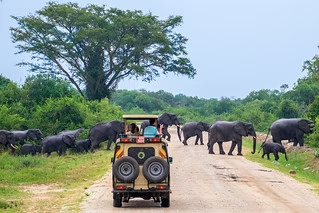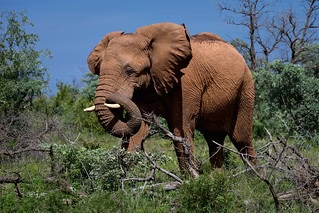Diverse mammals and predators.
Nyerere National Park is renowned for its exceptional mammal populations.
Large Herbivores
The park boasts significant populations of elephants, giraffes, zebras, and buffalo. Puku antelope, waterbucks, and sable antelope are among the species grazing in its plains.
Predators: Lions, leopards, and spotted hyenas thrive in the park. It also supports a rare and thriving population of African wild dogs, often spotted in packs during game drives.
Other Species: Hippopotamuses and Nile crocodiles dominate the Rufiji River, while black rhinos, though rare, add to the allure of the park’s conservation significance.
Birdlife and Aquatic Species
Bird enthusiasts will marvel at the park’s 400+ bird species, including African skimmers, pink-backed pelicans, and mangrove kingfishers. The wetlands and rivers provide perfect breeding grounds, ensuring vibrant birding experiences year-round.
Aquatic life, such as crocodiles and schools of fish, thrives in the river and lakes, which also serve as a lifeline for the park’s fauna.
Unique Experiences in Wildlife Viewing
Visitors can explore the park through various unique safari experiences:
Game Drives

The park’s extensive road network allows close encounters with diverse wildlife, particularly during the dry season when animals gather near water sources.
Boat Safaris
The Rufiji River offers a unique perspective on aquatic and land animals, providing an intimate experience with crocodiles, hippos, and riverside birds.
Walking Safari

These guided adventures immerse visitors in the park’s ecosystem, highlighting the flora, insects, and smaller wildlife.
Fly Camping
For adventurous travelers, lightweight camps offer a deeper connection with the wilderness.
Conservation Challenges
Despite its ecological richness, the park faces challenges such as poaching and habitat encroachment due to industrialization. The Tanzanian government, alongside NGOs, is actively working to combat these threats through anti-poaching initiatives and sustainable tourism.
Best Time to Visit
The dry season from June to October is ideal for wildlife viewing, as animals congregate near water bodies. During this period, visibility improves, making it easier to spot predators and herbivores alike.
Nyerere National Park is a must-visit for any safari enthusiast, offering unparalleled opportunities to witness wildlife in its rawest and most majestic form while also contributing to its conservation. Whether through game drives, river excursions, or cultural interactions, the park ensures an unforgettable wilderness experience.
 Nyerere National Park, Tanzania’s largest and a UNESCO World Heritage Site, is a sanctuary for some of Africa’s most iconic wildlife. Spanning over 30,000 square kilometers, the park is home to a rich variety of species, including majestic elephants, rare African wild dogs, and an array of vibrant birdlife.
Nyerere National Park, Tanzania’s largest and a UNESCO World Heritage Site, is a sanctuary for some of Africa’s most iconic wildlife. Spanning over 30,000 square kilometers, the park is home to a rich variety of species, including majestic elephants, rare African wild dogs, and an array of vibrant birdlife.


